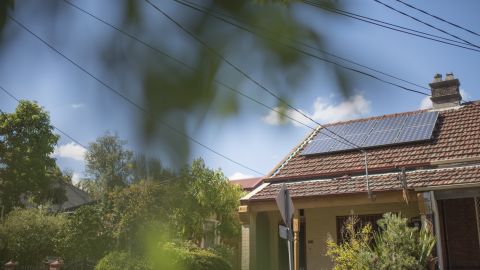Australians love their solar. Since 2001, we’ve put up over 23.2 million solar panels, which means there are now almost as many panels as people. As electricity costs continue to rise, now’s the time to tap into the economic, social and environmental rewards of going solar.
Here are some things to think about before you join the growing number of households with rooftop solar systems.
Solar benefits
Generating your own power is powerful. By going solar, you can help reduce greenhouse gas emissions and save money on your ever-increasing electricity bills.
By 2060, 80% of all people will call a city home. With such a dramatic concentration of people, city dwellers are crucial in confronting climate change.
Solar costs
Installing solar on your house is the most affordable it’s ever been. As a rough guide, getting solar up and running on your roof can cost anywhere from $1,000 to $2,000 per kilowatt (kW) installed.
The upfront cost depends on government rebates and schemes, the type and amount of panels and the type and size of your inverter. Your installation and monitoring costs also add to the bill.
The Alternative Technology Association provides free online solar and battery storage advice.

Solar rebates
2020 is a great year to switch to solar. National rebates are available but they will decrease every year until they drop to zero in 2032.
When you buy solar, the federal government offers a financial incentive called the ‘small scale technology certificate scheme’. The scheme provides a rebate for installing solar on your home, reducing your upfront costs. The value of the rebate depends on the number of panels you install, where you live and the year you install the system.
Best of all, the installer will apply the rebate so you don’t need to fill in any paperwork to make the saving. Any advertised prices you see almost certainly have the rebate already applied.
Payback periods
This is the amount of time it will take for your initial layout to be paid back by the savings you make with your solar system. While solar may have a longer payback period than other energy upgrades, the return on investment is usually very good and will likely increase the value of your property.
When it comes to solar, it’s all about the big picture payoff. Every household consumes energy differently, but Choice estimates the average payback period for a 5 kW system in Sydney is 4 years.
Solar system types
Before selecting a type of solar system, you need to understand how you use your energy. Study your electricity bill and measure your daily electricity consumption, including when it’s consumed. Then, before installing, examine the type and size of the solar system that will best suit your home. There are 2 options when locking in your sun-loving system.
Grid-connected solar systems are the most affordable. Any excess power goes back into the network and your provider will pay you back using feed-in tariffs.
Battery-backup solar systems are more expensive. They’re connected to the grid, but they have a battery backup to store excess power, which you can use or sell back to your electricity provider.
Batteries
Battery storage systems mean households can store their solar power for use later when needed, or store grid electricity during low cost times for use during more expensive peak periods. The cost of battery storage systems is coming down rapidly and is likely to be economically attractive for many households by 2020.
Other components
There are 2 core components to a solar system – panels and inverters.
Both mono and poly crystalline panels work well in the harsh Aussie sun, but make sure you choose a quality brand that’ll go the distance. When it comes to panels, you get what you pay for, so steer clear of ‘no-name’ modules.
Inverters convert the electricity from your solar panels into home-friendly 240 volts. There are 2 types. String inverters are usually big boxes installed to the side of your home. Microinverters are small units usually tucked behind each panel.
String inverters are less costly, but if only a single panel is shaded or malfunctions it affects the output of the entire system. This can be overcome by using microinverters or another add on technology called power optimisers. These options are more expensive, but they optimise each individual panel which helps generate more energy. It pays to go premium.
All about feed-in tariffs
These are the payments you get for any excess power your solar system feeds back into the grid. During peak times, when you would normally pay up to 40 cents per kWh to buy electricity from the grid, you can earn around 6 cents instead.
Sydney heritage considerations
Before adding panels to your rooftop, check if you live in a heritage conservation area. If you're unsure, contact the City's planning department.
Development application and installation details
As a general rule, if you live in a heritage conservation area, you’ll need to submit a DA.. If you’re not in a heritage area you do not have to do a DA.
If your system is attached to a wall or roof facing a primary road, it can’t protrude more than 0.5m from the point of attachment.
If your system isn’t attached to a wall or roof facing a primary road, it can’t protrude more than 1m from the point of attachment.
If it does protrude more than 0.5m, install your system more than 1m from any neighbouring property boundary.
Here are some more particulars on planning requirements.
Applying for a development application
To apply for a development application, you’ll need to complete and present the City with:
- an application form, copies of plans and supporting documentation on a USB
- a statement of effects for impacts on the environment, bordering premises or the public
- a digital set of scaled drawings for your development, as well as a contour and detail survey by a registered surveyor.
Read more about the City of Sydney’s application process.
Installation
There’s no shortage of solar installers on the market, so it pays to do your research and use a reputable supplier. Choosing an accredited designer and installer not only gives you peace of mind that your system is safe but also ensures you’re eligible for any rebates.

When you get a quote, make sure you ask for a site visit. While onsite, a professional installer can verify if your roof can support solar panels and account for radiation, roof direction, shading and cable routing. They should also inspect your switchboard and scope out a location for your inverter and panels. If you need professional structural advice, they’ll let you know.
Knowing what to expect from a supplier, and what you should expect to pay, will help you make the right decision. A rough guide is $1,000 per kWh.
Chris Barrett, commercial manager green infrastructure, City of Sydney says: “Ask for their references and make sure the panels you’re putting up are a reputable brand and come with a warranty.”
The next step
Lead the solar revolution in your neighbourhood – install solar on your house this spring.
Published 4 October 2018, updated 23 October 2020



